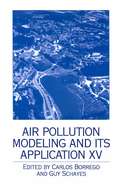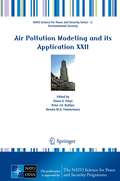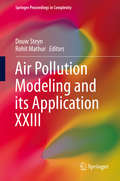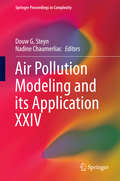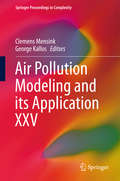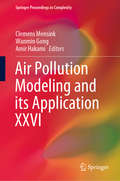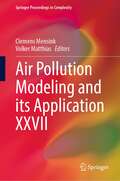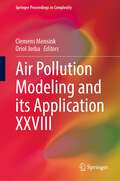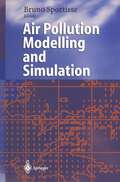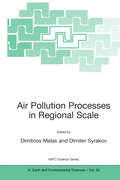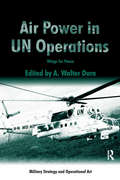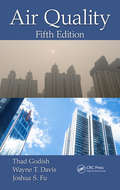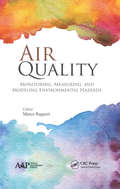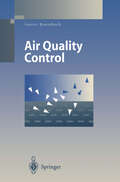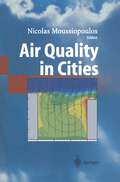- Table View
- List View
Air Pollution Modeling and its Application XV
by Carlos Borrego Guy SchayesIn 1969 the North Atlantic Treaty Organization (NATO) established the Committee on Challenges of Modern Society (CCMS). The subject of air pollution was from the start, one of the priority problems under study within the framework of various pilot studies undertaken by this committee. The organization of a periodic conference dealing with air pollution modelling and its application has become one of the main activities within the pilot study relating to air pollution. These international conferences were successively organized by the United States (first five); Federal Republic of Germany (five); Belgium (five); The Netherlands (four) and Denmark (five). With this one Portugal takes over the duty. This volume contains the papers and poster abstracts presented at the NATO/CCMS International Technical Meeting on Air Pollution Modelling and Its Application held in Louvain-la-Neuve, Belgium, during 15-19 October 2001. This ITM was jointly organized by the University of Aveiro, Portugal (Pilot country) and by the Catholic University of Louvain, Belgium (host country). The ITM was attended by 78 participants representing 26 countries from Western and Eastern Europe, North and South America, Asia, Australia and Africa. The main topics of this ITM were : Role of Atmospheric Models in Air Pollution Policy and Abatement Strategies; Integrated Regional Modelling; Global and Long-Range Transport; Regional Air Pollution and Climate; New Developments; and Model Assessment and Verification.
Air Pollution Modeling and Its Application XVI
by Carlos Borrego Selahattin IncecikThis volume covers the latest scientific developments in the real world applications of pollution modeling. Topics covered include: the role of atmospheric models in air pollution policy and abatement strategies; integrated regional modelling; global and long-range transport; aerosols as atmospheric contaminants; model assessment and verification; and application of new concepts in different regions of the world.
Air Pollution Modeling and its Application XVII
by Carlos Borrego Ann-Lise NormanIn 1969 the North Atlantic Treaty Organisation (NATO) established the Committee on Challenges of Modern Society (CCMS). The subject of air pol- tion was from the start, one of the priority problems under study within the fra- work of various pilot studies undertaken by this committee. The organization of a periodic conference dealing with air pollution modeling and its application has become one of the main activities within the pilot study relating to air pollution. The first five international conferences were organized by the United States as the pilot country; the second five by the Federal Republic of Germany; the third five by Belgium; the next four by The Netherlands; and the next five by Denmark; and with this one, the last three by Portugal. th This volume contains the papers and posters presented at the 27 NATO/CCMS International Technical Meeting on Air Pollution Modeling and Its Application held in Banff, Canada, 24-29 October 2004. The key topics at this ITM included: Role of Atmospheric Models in Air Pollution Policy and Abatement Strategies; Integrated Regional Modeling; Effects of Climate Change on Air Quality; Aerosols as Atmospheric Contaminants; New Developments; and Model Assessment and Verification. 104 participants from North and South America, Europe, Africa and Asia attended th the 27 ITM. The conference was jointly organized by the University of Aveiro, Portugal (Pilot Country) and by The University of Calgary, Canada (Host Country). A total of 74 oral and 22 poster papers were presented during the conference.
Air Pollution Modeling and its Application XX (NATO Science for Peace and Security Series C: Environmental Security)
by Douw G. Steyn S. T. RaoRecent developments in air pollution modelling are explored as a series of contributions from researchers at the forefront of their field. This book on air pollution modelling and its application is focused on local, urban, regional and intercontinental modelling; data assimilation and air quality forecasting; model assessment and evaluation; aerosol transformation; the relationship between air quality and human health and the effects of climate change on air quality. It consists of a series of papers that were presented at the 30th NATO/SPS International Technical Meeting on Air Pollution Modelling and its Application held in San Francisco, U.S.A., May 18-22, 2009. It is intended as reference material for students and professors interested in air pollution modelling at the graduate level as well as researchers and professionals involved in developing and utilizing air pollution models.
Air Pollution Modeling and its Application XXI (NATO Science for Peace and Security Series C: Environmental Security)
by Douw G. Steyn and Silvia Trini CastelliRecent developments in air pollution modeling and its application are explored here in contributions by researchers at the forefront of their field. The book is focused on local, urban, regional and intercontinental modeling; data assimilation and air quality forecasting; model assessment and evaluation; aerosol transformation; the relationship between air quality and human health and the effects of climate change on air quality. The work will provide useful reference material for students and professors interested in air pollution modeling at the graduate level as well as researchers and professionals involved in developing and utilizing air pollution models.
Air Pollution Modeling and its Application XXII (NATO Science for Peace and Security Series C: Environmental Security)
by Douw G. Steyn Peter J.H. Builtjes Renske M.A. TimmermansRecent developments in air pollution modeling and its application are explored here in contributions by researchers at the forefront of their field. The book is focused on local, urban, regional and intercontinental modeling; data assimilation and air quality forecasting; model assessment and evaluation; aerosol transformation; the relationship between air quality and human health and the interaction between climate change and air quality. The work will provide useful reference material for students and professors interested in air pollution modeling at the graduate level as well as researchers and professionals involved in developing and utilizing air pollution models.
Air Pollution Modeling and its Application XXIII (Springer Proceedings in Complexity)
by Douw Steyn Rohit MathurRecent developments in air pollution modelling are explored as a series of contributions from researchers at the forefront of their field. This newest contribution on air pollution modelling and its application is focused on local, urban, regional and intercontinental modelling; data assimilation and air quality forecasting; model assessment and evaluation; aerosol transformation. Additionally, this work also examines the relationship between air quality and human health and the effects of climate change on air quality. The work derives from a series of papers presented at the 33rd International Technical Meeting on Air Pollution Modelling and its Application held in Miami, USA, August 27 - 31, 2013. The book is intended as reference material for students and professors interested in air pollution modelling at the graduate level as well as researchers and professionals involved in developing and utilizing air pollution models.
Air Pollution Modeling and its Application XXIV (Springer Proceedings in Complexity)
by Douw G. Steyn Nadine ChaumerliacCurrent developments in air pollution modelling are explored as a series of contributions from researchers at the forefront of their field. This newest contribution on air pollution modelling and its application is focused on local, urban, regional and intercontinental modelling; data assimilation and air quality forecasting; model assessment and evaluation; aerosol transformation. Additionally, this work also examines the relationship between air quality and human health and the effects of climate change on air quality. The work is comprised of selected papers presented at the 34th International Technical Meeting on Air Pollution Modelling and its Application held in Montpellier, France in 2015. The book is intended as reference material for students and professors interested in air pollution modelling at the graduate level as well as researchers and professionals involved in developing and utilizing air pollution models.
Air Pollution Modeling and its Application XXV (Springer Proceedings in Complexity)
by Clemens Mensink George KallosCurrent developments in air pollution modelling are explored as a series of contributions from researchers at the forefront of their field. This newest contribution on air pollution modelling and its application is focused on local, urban, regional and intercontinental modelling; long term modelling and trend analysis; data assimilation and air quality forecasting; model assessment and evaluation; aerosol transformation. Additionally, this work also examines the relationship between air quality and human health and the effects of climate change on air quality.This Work is a collection of selected papers presented at the 35th International Technical Meeting on Air Pollution Modeling and its Application, held in Chania (Crete), Greece, Oct 3-7, 2016.The book is intended as reference material for students and professors interested in air pollution modelling at the graduate level as well as researchers and professionals involved in developing and utilizing air pollution models.
Air Pollution Modeling and its Application XXVI (Springer Proceedings in Complexity)
by Clemens Mensink Wanmin Gong Amir HakamiCurrent developments in air pollution modeling are explored as a series of contributions from researchers at the forefront of their field. This newest contribution on air pollution modeling and its application is focused on local, urban, regional and intercontinental modeling; emission modeling and processing; data assimilation and air quality forecasting; model assessment and evaluation; atmospheric aerosols. Additionally, this work also examines the relationship between air quality and human health and the effects of climate change on air quality.This work is a collection of selected papers presented at the 36th International Technical Meeting on Air Pollution Modeling and its Application, held in Ottawa, Canada, May 14-18, 2018.The book is intended as reference material for students and professors interested in air pollution modeling at the graduate level as well as researchers and professionals involved in developing and utilizing air pollution models.
Air Pollution Modeling and its Application XXVII (Springer Proceedings in Complexity)
by Clemens Mensink Volker MatthiasThis book is intended as reference material for students and professors interested in air pollution modeling at the graduate level as well as researchers and professionals involved in developing and utilizing air pollution models. Current developments in air pollution modeling are explored as a series of contributions from researchers at the forefront of their field. This newest contribution on air pollution modeling and its application is focused on local, urban, regional and intercontinental modeling; emission modeling and processing; data assimilation and air quality forecasting; model assessment and evaluation; aerosol transformation. Additionally, this work also examines the relationship between air quality and human health and the effects of climate change on air quality.This work is a collection of selected papers presented at the 37th International Technical Meeting on Air Pollution Modeling and its Application, held in Hamburg, Germany, September 23-27, 2019.
Air Pollution Modeling and its Application XXVIII (Springer Proceedings in Complexity)
by Clemens Mensink Oriol JorbaThis book states that current developments in air pollution modeling are explored as a series of contributions from researchers at the forefront of their field. This newest contribution on air pollution modeling and its application is focused on local, urban, regional and intercontinental modeling; long-term modeling and trend analysis; data assimilation and air quality forecasting; model assessment and evaluation; aerosol transformation. Additionally, this work also examines the relationship between air quality and human health and the effects of climate change on air quality.This work is a collection of selected papers presented at the 38th International Technical Meeting on Air Pollution Modeling and its Application, held in Barcelona, Spain, Oct 18–22, 2021. The book is intended as reference material for students and professors interested in air pollution modeling at the graduate level as well as researchers and professionals involved in developing and utilizing air pollution models.
Air Pollution Prevention and Control: Bioreactors and Bioenergy
by Christian Kennes Maria C. VeigaOver the past two decades, the use of microbes to remove pollutants from contaminated air streams has become a widely accepted and efficient alternative to the classical physical and chemical treatment technologies. This book focuses on biotechnological alternatives, looking at both the optimization of bioreactors and the development of cleaner biofuels. It is the first reference work to give a broad overview of bioprocesses for the mitigation of air pollution. Essential reading for researchers and students in environmental engineering, biotechnology, and applied microbiology, and industrial and governmental researchers.
Air Pollution Prevention and Control: Bioreactors and Bioenergy
by Christian Kennes Maria C. VeigaOver the past two decades, the use of microbes to remove pollutants from contaminated air streams has become a widely accepted and efficient alternative to the classical physical and chemical treatment technologies. This book focuses on biotechnological alternatives, looking at both the optimization of bioreactors and the development of cleaner biofuels. It is the first reference work to give a broad overview of bioprocesses for the mitigation of air pollution. Essential reading for researchers and students in environmental engineering, biotechnology, and applied microbiology, and industrial and governmental researchers.
Air Pollution Processes in Regional Scale (NATO Science Series: IV: #30)
by Dimitrios Melas Dimiter SyrakovAn understanding of long-range transport of air pollutants in the atmosphere requires a knowledge of the relevant atmospheric dynamic and chemical processes active at the regional scale as well as the temporal and spatial distribution of emissions. Numerical modeling is the most efficient way to determine the atmospheric transport, photochemistry and deposition pathways. The book therefore discusses the physical and chemical processes that determine regional air pollution and presents the relevant modeling techniques to describe the different atmospheric processes that are active at that scale.
Air Power in UN Operations: Wings for Peace (Military Strategy and Operational Art)
by A. Walter DornAir power for warfighting is a story that's been told many times. Air power for peacekeeping and UN enforcement is a story that desperately needs to be told. For the first-time, this volume covers the fascinating range of aerial peace functions. In rich detail it describes: aircraft transporting vital supplies to UN peacekeepers and massive amounts of humanitarian aid to war-affected populations; aircraft serving as the 'eyes in sky' to keep watch for the world organization; and combat aircraft enforcing the peace. Rich poignant case studies illuminate the past and present use of UN air power, pointing the way for the future. This book impressively fills the large gap in the current literature on peace operations, on the United Nations and on air power generally.
Air Power in UN Operations: Wings for Peace (Military Strategy and Operational Art)
by A. Walter DornAir power for warfighting is a story that's been told many times. Air power for peacekeeping and UN enforcement is a story that desperately needs to be told. For the first-time, this volume covers the fascinating range of aerial peace functions. In rich detail it describes: aircraft transporting vital supplies to UN peacekeepers and massive amounts of humanitarian aid to war-affected populations; aircraft serving as the 'eyes in sky' to keep watch for the world organization; and combat aircraft enforcing the peace. Rich poignant case studies illuminate the past and present use of UN air power, pointing the way for the future. This book impressively fills the large gap in the current literature on peace operations, on the United Nations and on air power generally.
Air Purifier: Property, Assessment and Applications
by Zhonglin XuThis book discusses the development, types and application principles of portable air purifiers in China. It analyzes the theoretical characteristics of air purifiers under various operational conditions, and points out that the term “Clean Air Delivery Rate” cannot be used to precisely reflect the problems that occur under various operational conditions. By comparing theoretical and measured data, it highlights the mainfeatures of air purifiers and key points in the design process for different applications. Calculation methods for the indoor particle concentration and the self-purification time are also provided. The book describes the conditions for window opening in smog and for selecting air purifiers, and proposes a newmethod for improvingtheir measurement. In closing, it includes a new assessment index.
Air Quality
by Thad Godish Wayne T. Davis Joshua S. FuThe fifth edition of a bestseller, Air Quality provides students with a comprehensive overview of air quality, the science that continues to provide a better understanding of atmospheric chemistry and its effects on public health and the environment, and the regulatory and technological management practices employed in achieving air quality goals.
Air Quality: Monitoring, Measuring, and Modeling Environmental Hazards
by Marco RagazziThis title includes a number of Open Access chapters. This new compendium provides a nuanced look at monitoring, measuring, and modeling air quality pollution in conjunction with its effects on public health and the environment. Air pollution has been proven to be a major environmental risk to health. Protecting and improving air quality requires knowledge about the types and levels of pollutants being emitted. It also requires the best possible measurement and monitoring capabilities. The chapters in this volume serve as a foundation for monitoring, measuring, and modeling air pollution.
Air Quality: Monitoring, Measuring, and Modeling Environmental Hazards
by Marco RagazziThis title includes a number of Open Access chapters. This new compendium provides a nuanced look at monitoring, measuring, and modeling air quality pollution in conjunction with its effects on public health and the environment. Air pollution has been proven to be a major environmental risk to health. Protecting and improving air quality requires knowledge about the types and levels of pollutants being emitted. It also requires the best possible measurement and monitoring capabilities. The chapters in this volume serve as a foundation for monitoring, measuring, and modeling air pollution.
Air Quality and Human Health
by Markus Hecker Pratap Kumar Padhy Soumya Niyogi Pulak Kumar PatraThe book is one of the outcomes of the SPARC (Scheme for Promotion of Academic and Research Collaboration) project titled "Fine particulates matters in the air environment and their cancer risks in human beings," sponsored by MHRD (now MoE), Govt. of India. The editors of the book are PIs and Co-PIs of the said project. The text deliberates on air pollution's health risks with contributions from well-known experts from diverse research fields (environmental science, toxicology, geology, public health science, biology, physics, chemistry, and geospatial technology). It explores it its control and mitigation strategies. The book provides an up-to-date overview of the modern methods and tools used in air quality monitoring and human health risk assessment. Case studies from different global settings offer invaluable insights into air pollution-related regional health issues. It addresses all aspects of air quality, covering indoor-outdoor air pollution, gaseous and particulate pollutants; characterization of source and pathways of air pollutants; and the modeling and assessing of health risks (respiratory, epidemiological, and toxicological) with regional and global perspectives. It also addresses air quality management issues. The lucid explanation of the role of oxidative stress mechanisms and molecular biomarkers (genomics, proteomics) may be considered as inputs into the development of cancer therapeutics. Along with providing a scientific basis for air pollution, this book will help readers appreciate the environmental determinants of public health and apply research evidence to improve the quality of life. It also delineates future research initiatives and policy actions needed to protect human health from air pollution, locally and globally. The book will be of great educational value and help for consultation and teaching.
Air Quality Control: Formation and Sources, Dispersion, Characteristics and Impact of Air Pollutants — Measuring Methods, Techniques for Reduction of Emissions and Regulations for Air Quality Control (Environmental Science and Engineering)
by G. BaumbachAir quality and air pollution control are tasks of international concern as, for one, air pollutants do not refrain from crossing borders and, for another, industrial plants and motor vehicles which emit air pollutants are in widespread use today. In a number of the world's expanding cities smog situations are a frequent occurrence due to the number and emission-intensity of air pollution sources. Polluted air causes annoy ances and can, when it occurs in high concentrations in these cities, constitute a seri ous health hazard. How important clean air is to life becomes apparent when consid ering the fact that humans can do without food for up to 40 days, without air, how ever, only a few minutes. The first step towards improving the air quality situation is the awareness that a sound environment is as much to be aspired for as the development of new tech nologies improving the standard of living. Technical progress should be judged es pecially by how environmentally benign, clean and noiseless its products are. Of these elements, clean air is of special concern to me. I hope that this book will awaken more interest in this matter and that it will lead to new impulses. Due to the increasing complexity of today's machinery and industrial processes science and technology can no longer do without highly specialized design engineers and opera tors. Environmental processes, however, are highly interdependent and interlinked.
Air Quality in Cities
by Nicolas MoussiopoulosUrban areas are major sources of air pollution. Pollutant emissions affecting air quality in cities are considered to have adverse consequences for human health. Public and government concern about environmental issues arising from urban air pollution has increased over the last decades. The urban air pollution problem is widespread throughout the world and it is important to find ways of eliminating or at least reducing the risks for human health. The fundamentals of the physical and chemical processes occurring during air pollutant transport in the atmosphere are nowadays understood to a large extent. In particular, modelling of such processes has experienced a remarkable growth in the last decades. Monitoring capabilities have also improved markedly in the most urban areas around the world. However, neither modelling nor monitoring can solve urban air pollution problems, as they are only a first step in improving useful information for future regulations. The defining of efficient control strategies can not be achieved without a clear knowledge of the complete pollution process, i.e. emission, atmospheric transport and transformation, and deposition at the receptor. Improving our ability to establish valid urban scale source-receptor relation ships has been the objective of SA TURN, one of the 14 subprojects of EURO TRAC-2. Similar to the other subprojects of this co-ordinated environmental pro ject within the EUREKA initiative, SA TURN brought together international groups of scientists to work on problems directly related to atmospheric chemistry and physics. The present volume summarises the scientific results of SATURN.
